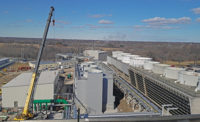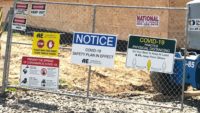Viewpoint: The Jobsite Workforce
Don't Let Technology Obscure the Real Heart of the Construction Process
A reminder about what's important, from a construction estimator


Over the last three years, technology has smashed like a wrecking ball the notion that construction is just work boots and weathered hands. It has created a completely new way of looking at construction and created a brand new workforce. Rather than walking around a jobsite with a tool belt and a tape measure, the new construction professional is more likely to be seen holding a tablet and a stylus. 3D modeling, building information modellng and image mapping have taken the jobsite by storm.
I started working in construction in 2003, seven years before the iPad appeared, as a union apprentice out of plumbers' Local 130 in Chicago. I worked on projects ranging from small tenant improvements to 17-story condominiums. I have dug trenches by hand in the rain and installed faucets in buildings in the winter. The greatest technological development I saw in my four years as an apprentice was an underground plumbing piping plan that we had laminated to protect it from the elements.
A foundation is not built in SketchUp; it is built in the hard and weathered dirt by hard and weathered men and women.
Shortly after becoming a journeyman in 2007, I accepted a position as the plumbing estimator for one of the largest plumbing companies in Chicago. The first item I received when I sat down at my desk was a Scale Master Classic Digital Plan Measure tool. We estimators called them rollers. That was how you performed quantity take-offs for plumbing piping before inputting the information into an Excel spreadsheet to formulate a bid. You did everything on a paper set of plans and highlighted the items as you performed your take-off so you would not double count anything. If you were lucky enough to get a scope review meeting with your client, you showed up at their office with your full-size set of plans, marked up and drawn on like a coloring book.
Fast forward to 2014. I move into the role of estimator for a large, national, general contractor. We use things like On-Screen Takeoff and Earthworks—a small step up from generating quantity take-offs by hand back in 2007. What I witnessed over the next three years of my career was not just a giant leap in construction technology but several bounds, one after another. My roller now sits in a drawer along with fifty colored pencils, and my architect's ruler has become my back scratcher. I walk into meetings with my laptop and I get dirty looks from the others sitting around the table with their Surface Pros.
Drones are now mapping out our jobsites and virtual reality is taking us through buildings that have not yet even been built. Contractors across the country are sprinting to keep up with technological advancements and scrambling to hire tech-savvy college graduates. Those young professionals walk around the jobsite with a tablet containing all the new construction applications for streamlining the schedule, optimizing cost projections and analyzing the myriad of data they input. They barely have a second to look up and see the building they are constructing, let alone what is really at the heart of construction—the tradespeople.
It is amazing to see a building get built in the digital realm, to spin a model 360º to see every corner of it, to digitally map an existing building and see all the walls, pipes, doors, windows and so on. You could spend every day reading articles about new software companies breaking into the market or new apps to download or new automated equipment for such things as laying brick. It is both exciting and overwhelming.
Behind the BIM Models
It is also disappointing, because behind every BIM model, behind every digital map, behind every 4D schedule are work boots and weathered hands. No matter how savvy we get inside our cubicle—sorry, I mean open-plan workstation—construction still comes down to raw materials and raw labor. A foundation is not built in SketchUp; it is built in the hard and weathered dirt by hard and weathered men and women. These men and women bring the design to life. They are the ones building the forms, sweating the pipe, bolting the steel, driving the excavators, setting the tiles. They start early, work in all weather and catch the mistakes in the drawings. Their sweat is on every piece of construction data we can now collect at the snap of a finger. And these days there are too few of them and too few young people interested in joining them. We need them now more than ever.
Technology will continue to advance construction, making it safer, helping projects run smoother and opening it up to a whole new workforce. That should be celebrated, as long as we don't forget about the heart of our projects, the heart of our buildings, the heart of our industry: the hardhats, the skilled craft workers, the people with the work boots and weathered hands.
Jason Seiler is a senior estimator at Graycor Construction and can be reached at Jason_Seiler@graycor.com



